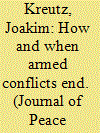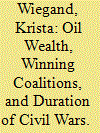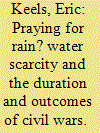|
|
|
Sort Order |
|
|
|
Items / Page
|
|
|
|
|
|
|
| Srl | Item |
| 1 |
ID:
094689


|
|
|
|
|
| Publication |
2010.
|
| Summary/Abstract |
What explains the effect of external intervention on the duration of civil war? The literature on intervention has made some progress in addressing this question, but it has been hindered by an assumption that states intervene in civil wars either to help one side win or to facilitate negotiations. Often, however, external states become involved in civil war to pursue an agenda which is separate from the goals of the internal combatants. When states intervene in this fashion, they make wars more difficult to resolve for two reasons. First, doing so introduces another actor that must approve any settlement to end the war. Second, external states generally have less incentive to negotiate than internal actors because they bear lower costs of fighting and they can anticipate gaining less benefit from negotiation than domestic insurgents. Through Cox regressions using data on the goals of all interventions in civil wars since World War II, this article shows that when states intervene with an independent agenda, they make wars substantially longer. The effect of independent interventions is much larger than that of external interventions generally, suggesting that the established finding that external interventions prolong civil war is driven by a subset of cases where states have intervened in conflicts to pursue independent goals.
|
|
|
|
|
|
|
|
|
|
|
|
|
|
|
|
| 2 |
ID:
094704


|
|
|
|
|
| Publication |
2010.
|
| Summary/Abstract |
This article presents new data on the start and end dates and the means of termination for armed conflicts, 1946-2005. These data contribute to quantitative research on conflict resolution and recurrence in three important respects: the data cover both interstate and intrastate armed conflicts, the data cover low-intensity conflicts, and the data provide information on a broad range of termination outcomes. In order to disaggregate the UCDP-PRIO Armed Conflict dataset into multiple analytical units, this dataset introduces the concept of conflict episodes, defined as years of continuous use of armed force in a conflict. Using these data, general trends and patterns are presented, showing that conflicts do not exclusively end with decisive outcomes such as victory or peace agreement but more often under unclear circumstances where fighting simply ceases. This pattern is consistent across different types of conflict, as is the finding that victories are more common in conflicts with short duration. The article then examines some factors that have been found to predict civil war recurrence and explores whether using the new dataset produces similar results. This exercise offers a number of interesting new insights and finds that the determinants for civil war recurrence identified in previous research are sensitive to alternate formulations of conflict termination data. The findings suggest that intrastate conflicts are less likely to recur after government victories or after the deployment of peacekeepers. If the previous conflict is fought with rebels aiming for total control over government or if the belligerents mobilized along ethnic lines, the risk of recurrence increases. The discrepancy in findings with previous research indicates the need for further study of conflict resolution and recurrence, for which this dataset will be useful.
|
|
|
|
|
|
|
|
|
|
|
|
|
|
|
|
| 3 |
ID:
165266


|
|
|
|
|
| Summary/Abstract |
New research has begun to underscore the complicated relationship between democratic institutions and the duration of civil wars. Specifically, greater constraints placed on executives often lead to considerably longer civil wars as leaders are limited in how they bargain with dissidents. This presents a puzzle as democracies are often seen as credible negotiators in international disputes. This article suggests that the size of the government’s winning coalition represents a double-edged sword. Larger winning coalitions allow governments to bargain more credibly but also place constraints on what governments can offer since peace agreements may alienate coalition members. Fortunately, future access to postwar oil wealth provides the feasibility for the governments to compensate hard-liners who may lose out on any settlement, making them more likely to allow concessions to rebels. This combined credibility of large winning coalitions and the feasibility provided by oil wealth allows for peace agreements, therefore shortening the duration of civil wars. We test these propositions by examining the conditional relationship between oil wealth and coalition size on the duration of all civil wars between 1950 and 2009.
|
|
|
|
|
|
|
|
|
|
|
|
|
|
|
|
| 4 |
ID:
164517


|
|
|
|
|
| Summary/Abstract |
Recent anecdotal evidence from the civil wars in Somalia and Yemen suggest that water scarcity may shape the dynamics of civil wars. While a considerable body of research has examined the connection between water scarcity (such as low rainfall) and the onset of civil war, very little research has examined how water scarcity may shape the duration and outcomes of civil wars. Looking specifically at rainfall, this paper argues that changes in access to water play a key role in the duration of civil wars. As rainfall declines, there is a reduction in resources available to both the government and the rebel group, leading to a stalemate in fighting. Furthermore, this paper argues that declines in rainfall are felt more acutely by rebel groups who seek to challenge the government through conventional warfare. This paper tests these propositions using hazard models. The results provide robust support for the propositions.
|
|
|
|
|
|
|
|
|
|
|
|
|
|
|
|
|
|
|
|
|